Alumni Catch Up
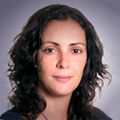
Catching up with...Dr. Filipa Tomé
Filipa was a member of the CEPLAS Postdoc Programme till February 2018. Currently she is working at the Biosystems & Integrative Sciences Institute (BioISI) in Lisbon.
Where are you working now and since when?
I am working at the Biosystems & Integrative Sciences Institute (BioISI) at the Faculty of Sciences of the University of Lisbon. I joined the team in February 2018.
What is your research about? / In what are you working?
I am working both as Knowledge and Technology Transfer and Outreach Officer. My main tasks are to identify major strengths and research ideas for collaborations with academia and industry, and follow the path from a basic research idea to a possible innovative solution with economic value. I am also part of the Outreach Group, where we do the scientific communication of the Institute.
What is the size of the group you are working with?
BioISI has more than 250 researchers, working on different fields such as Biomedicine, Biotechnology, and Physics. I work closely with the director and two colleagues that support the managing tasks of the Institute.
What is different in your lab than working at MPIPZ?
At the MPI I was doing research, both in the lab and in the greenhouse. Now I am divided between my desk and meetings with scientists and collaborators. My first challenge was to get to know the research topics of all the groups! For me, it is a privilege to be able to follow closely on scientific advances in many fields, and to meet so many different scientists.
Where are your colleagues from?
Most of my colleagues are Portuguese. We do have a German colleague, so I get to practice German sometimes!
Did your new colleagues new about CEPLAS?
Not CEPLAS specifically, but the groups that work in plant biology knew about most of the groups and Universities that are part of CEPLAS. We also have strong collaborations with EMBL in Heidelberg and the University of Regensburg.
Which part of the CEPLAS Postdoc Programme helped you to get your current position?
I am sure my experience within CEPLAS was crucial for my career. Obviously, being part of such a high profile cluster and surrounded by very talented scientists can only enrich a scientific career. My experience as young researcher representative and many of the industry related CEPLAS activities were important for my new job.
What do you think about CEPLAS from a retrospective view?
CEPLAS was a very fruitful experience and a major step in my career. I enjoyed being part of the cluster and it helped me grow both professionally and personally.
Are you still in touch with your former colleagues?
Yes! I made very good friends during my stay in Germany and we are still in touch. Some already visited me in Lisbon, and others will follow soon!
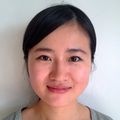
Catching up with...Panpan Jiang
Panpan finished her PhD in the CEPLAS Graduate School in 2017. Now she works in the R&D team of Dümmen Organge, an international leading breeding company.
Where are you working now and since when?
I am working since May 2017 in the R&D team (Rheinberg) of Dümmen Orange (DO), an international leading breeding company focused on cut flowers, bulbs, tropical plants, pot plants, bedding plants and perennials.
What is your research about? / In what are you working?
I work in the technology development team to develop and establish lab protocols aiming to accelerate the breeding process.
What is the size of the group you are working with?
We are 6 people in total including 2 interns.
What is different in your lab than working at UoC?
I like the research work both at UoC and at DO a lot, but at DO (I’d say in general in all industries) the research is very application/profit oriented.
Where are your colleagues from?
We are a quite international team from Asia, USA and Europe.
Did your new colleagues knew about CEPLAS?
In my team it is not very well known. However, as I got to know DO through CEPLAS events, some people from the company’s Holland site do know about CEPLAS quite well.
Which part of the CEPLAS Graduate School helped you to get your current position?
I got to know DO through CEPLAS industry speed dating event (twice). I checked their open positions online and just applied.
What do you think about CEPLAS from a retrospective view?
Looking back I really appreciate the various events CEPLAS organized. For example the young researcher’s seminar helped me to build ties with peers and I see them as very important connections. Also the industry trips organized by CEPLAS helped me a lot in getting to know how it is like to be working in industry.
Are you still in touch with your former colleagues?
Yes, I try to keep in touch and meet up with some former colleagues from time to time.
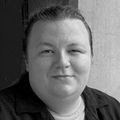
Catching up with... Prof. Dr. Andrea Bräutigam
Andrea worked at the Institute of Plant Biochemistry at HHU and participated in the CEPLAS Postdoc Programme. In October 2017 she accepted a W2 position in Computational Biology at Bielefeld University.
Where are you working now and where else have you been working after being a member of the CEPLAS postdoc programme?
I worked as an independent group leader for network analysis and modelling at the IPK Gatersleben in 2016 and 2017 and moved to the University Bielefeld as a W2 Professor in October 2017
What is your current research about? What is the size of the group?
I still research C4 photosynthesis, these days using kinetic and stoichiometric modelling. I study transcriptional regulatory networks in wheat, barley, and Arabidopsis. Most recently I have launched analyses of the transcriptional regulatory networks for photosynthetic control. The group consists of a postdoc and a master student still in Gatersleben and a new team in Bielefeld of currently five people which will probably expand in the near future.
What is different in your current lab than working at HHU?
When at HHU, I still worked in the lab – at least occasionally. At IPK I transitioned into a purely theoretical position. Now I supervise both theoretical experiments in the computer and practical experiments in the lab.
Did your new colleagues know about CEPLAS?
Yes, they did and do. The knowledge is mostly superficial though – they know CEPLAS as the successful excellence initiative program focused on plants but generally do not know details about its objective and achievements.
Do you think any offer of the CEPLAS Postdoc Programme /the CEPLAS network helped you to get your current and former position?
Throughout my career I have benefitted from structured programs, be it in CEPLAS or in the EU program 3to4, since they allowed me access to networks and resources and fostered professional development. But – as far as I know – there was no direct influence on either of the positions.
What do you think about CEPLAS from a retrospective view?
It was fun (still is, since it is ongoing and alumni can attend meetings)! I think large programs can be cumbersome and a lot of work, but their advantages outweigh these disadvantages by far: the combined expertise available, the immediate contact with many researchers on all experience levels, and the exciting science made possible.
Are you still in touch with your former colleagues?
Yes, I am. It probably helps that I have stayed in academic science and have not switched fields. You run into each other at meetings and conferences.
How was it to join CEPLAS Symposium as an alumnus?
I enjoyed it but it felt a bit strange. Time put some distance between me and CEPLAS. It was exciting to learn about the current projects and discuss the science but I was conscious about CEPLAS moving on beyond what I was a part of. I am looking forward to future meetings and to what CEPLAS will do in the next phase.

Catching up with..... Dr. Elia Stahl
Elia was the first graduate from the CEPLAS Grad School and is now working as a postdoc in Lausanne, Switzerland. Recently, he participated at the CEPLAS Symposium and shared his experience with us. Read more!
Where are you working now and since when?
Since 01.06.2016 I’m working at the University of Lausanne with Philippe Reymond in the Department of Plant Molecular Biology (DBMV).
What is your research about? What is the aim of your research project?
In the Lab of Philippe Reymond we are interested in plant-herbivore interactions. My main project focuses on the characterization of egg-derived elicitors, which activate plant defense signalling in response to insect oviposition in Arabidopsis.
What is the size of the group you are working with?
We are currently 8 scientists in the group of Philippe Reymond.
What is different in your lab than working at HHU?
Well, it’s organised quite differently since the working groups of the department have a lot of shared facilities, e.g. qPCR machines and microscopes don’t belong to specific groups. Sometimes even scientists from different groups share offices. That way you get easily incorporated with the research of the other groups and there is a lot of exchange and networking between groups. In total, the plant science groups from our department are spread out over 2 floors of the building.
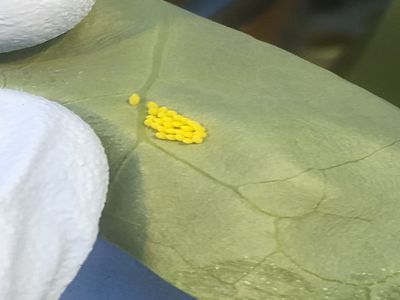
Where are your colleagues from?
It’s very international! English is the common language and actually only very few are from Switzerland.
Did your new colleagues know about CEPLAS?
Some of the PIs did know CEPLAS before, but for postdocs and PhDs it was rather unknown.
Do you think any measurement (courses/excursion/mentoring etc.) of the CEPLAS Graduate School Programme were helpful for you to get your current position?
For me it was really good that CEPLAS gave me the opportunity to join some conferences. I got in contact with my current PI during a conference I visited during my PhD.
What do you think about CEPLAS from a retrospective view?
Seeing the whole cluster, I think there is now a lot more cooperation between different CEPLAS groups than in the first years. However, in my research field (plant defense) the cooperation always had worked out very well.
Are you still in touch with your former colleagues?
Yes, with my former PI Jürgen Zeier I'm in contact from time to time. I stay in touch as well with some of the PhDs and Postdocs, but rather on a friendship than scientific level.
How was it to join CEPLAS Symposium as an alumnus?
Nice to be back and to see former colleagues! I think after having been in the cluster for several years it’s very good to stay and keep in touch.
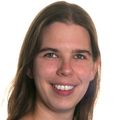
Catching up with..... Dr. Wilma van Esse
For the first CEPLAS alumnus interview in our new series we caught up with Wilma van Esse. In 2013 she joined CEPLAS as one of the first postdocs of the cluster and worked in the group of Maria von Korff at the MPI for Plant Breeding Research. Since the beginning of this year she is setting up her own research group at Wageningen University.
Where are you working now and since when?
Last year I received a 3-year VENI grant (from the Dutch veni-vidi-vici Innovational Research Incentives Scheme), which enabled me to start my independent research project. Since January 2017, I am performing my research at Wageningen University within the Plant Developmental Systems (PDS) group at the Department of Molecular Biology.
What is your research about?
Temperate cereals such as barley and wheat are important crops for food and feed supply. Within my project I study the trait-off between different yield components in barley, such as shoot branching, seed number and weight. This is challenging as the same genes or regulatory modules often affect multiple traits. Negative correlations between these traits limit the improvement of yield, and these correlations are hard to break using conventional breeding methods. Optimizing yield trough modification of seed and shoot number is possible, but requires an in-depth knowledge about the genes and regulatory modules that affect these traits. The way I am studying this is by detailed analyses of the molecular pathways that affect seed size and number as well as overall plant architecture.
Do you have co-workers on that topic?
My research is embedded within the group of Prof. Richard Immink, who is addressing very similar research questions, but works with Arabidopsis thaliana as model plant. Besides the fundamental studies in Arabidopis, there are also non-model plants studied ranging from several vegetables crops to ornamental flowers such as tulip. At the moment I’m working together with a BSc. student to identify interaction partners of the transcription factor INT-C(Hv.TB1), which affects both inflorescence and shoot branching. There are many opportunities to attract university students for a thesis project in which they can support ongoing research.
Although I am the only scientist within the group working on temperate cereals, I do get a lot of support and feedback that enables me to set up and perform my research. Overall, there is a great atmosphere in the group and there is a lot of collaboration going on. We have the joint long-term goal to apply knowledge gained from Arabidopsis to different crops. In my case, I will focus on temperate cereals such as barley and wheat.
What is different in your lab than working at MPIPZ?
Even though I enjoyed my time at MPIPZ a lot, it’s great to be more independent now and to be able to run my own research project.
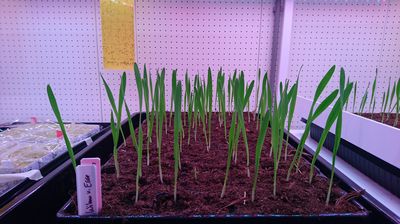
Where are the other scientists at the department from and did they know CEPLAS before?
Within the Department of Molecular Biology there is a quite diverse and international team, we have scientists from the Netherlands, but also from other countries such as India, Germany, Italy, Brazil and China. Most of them did not know CEPLAS before. However, when I registered at the graduate school Experimental Plant Sciences (EPS), it was clear that they knew CEPLAS.
Which part of the CEPLAS Postdoc Programme helped you to get your current position?
Coaching was very helpful! I took a few coaching sessions with Markus Holzheimer, and I even received coaching between the different steps of the grant interview that prepared me for that challenging situation. Furthermore, I took a course in grant writing and could apply the knowledge when applying for the VENI grant. I also appreciate the mentoring programme. When I told my mentor (Prof. Francine Govers, Wageningen UR) about my plans to write a grant and start an own topic, she advised me to go to the Department of Molecular Biology at Wageningen UR. This was an excellent suggestion as the research topics within this group fit with my interest and my future vision for my research. Combined, the coaching, mentoring and grant writing course gave me a good basis to apply for my own funding.
What do you think about CEPLAS from a retrospective view?
I really liked the positive support for postdocs! While graduate schools for PhD students are quite common, postdoc programmes are not. Often it is difficult as a postdoc to prove your experience (teaching, scientific courses etc.) when applying for a new position or a grant and therefore I appreciated a lot the certificate I received when finishing the postdoc programme.
Are you still in touch with your former colleagues?
Yes, definitely. The main contact is with the former group I worked in (Maria von Korff), especially with current PhD students and the new postdocs who took over my former project. However, whenever I go to MPIPZ, I try to catch up with colleagues from other groups as well.
How was it to join CEPLAS Symposium as an alumnus?
It’s nice to follow up! I think it’s very important to stay in touch with your research network, especially as I was quite a few years in the CEPLAS community. Actually today I was talking with one of the PIs and the idea of a joint application came up, which would be really great!